A hole saw is a tool used to cut clean, round holes in various materials. It is a versatile tool that can be attached to drills or drill presses. These tools are often used in construction and DIY projects where precise holes are needed.
Hole saws can cut through wood, metal, concrete, glass, tile, and plastic. This makes them handy for many projects, from installing doorknobs to running wiring through walls. Craftspeople also use them for creating detailed work in their projects.
Using a hole saw requires two main components: the saw blade and the arbor. The saw blade is the cutting part and comes in different sizes. The arbor attaches the saw to the drill. This setup allows for the creation of holes with smooth edges, making it easier to complete professional-looking projects.
For more details on how to use a hole saw, visit the Family Handyman guide.
Understanding Hole Saws
Hole saws are versatile tools used to cut holes in various materials like wood, metal, and plastic. They are widely used in woodworking, plumbing, and metalworking for creating clean, round holes.
Components and Design
A hole saw typically consists of a saw blade with sharp saw teeth and a pilot drill in the center.
The arbor or mandrel connects the saw to a drill or drill press. It has drive pins and a collar to ensure the saw remains stable. The arbor also allows quick changes of saw sizes.
As the hole saw cuts, it produces sawdust, chips, and wood plugs that need to be cleared from slots in the saw blade. The clearing of these materials is crucial for efficient cutting and maintaining stability.
Types of Hole Saws
There are different types of hole saws designed for specific applications.
- Bi-metal hole saws: Made from two kinds of metal, they are durable and versatile.
- Carbide-tipped hole saws: Excellent for cutting through hard materials like ceramic and stone.
- Diamond hole saws: Ideal for tile and glass, they have a rim coated with tiny diamonds for cutting.
A hole saw kit usually includes a variety of sizes to cover different diameter holes.
Forstner bits or spade bits are other types of drill bits that can be used for making holes, but they have different designs and uses.
Operating Principles
To use a hole saw, the user first drills a pilot hole with the pilot drill. This helps to guide the hole saw and keep it stable.
By attaching the hole saw to the drill or drill press, the user ensures proper torque and control.
Efficient cutting involves managing the dust and debris produced. This can be done by regularly clearing the slots. Sharp saw teeth and a stable arbor also contribute to efficient cutting and prevent the saw from binding in the material.
Proper use of a hole saw requires attention to the workpiece and the chosen tool type to achieve the best results.
Practical Applications and Best Practices
Hole saws are very versatile and can be used for many tasks. They are essential in woodworking, plumbing, and electrical projects.
Usage Scenarios
Hole saws cut through different materials like wood, porcelain, metals, and plastics. In woodworking, they create holes for doorknobs and locks. They are also useful for installing door hardware.
For plumbers, a hole saw is great for making holes in pipes. It’s also helpful for ductwork. Electricians use hole saws when running wires through drywall. They can easily make holes for electrical boxes.
Crafts and DIY projects also benefit from hole saws. They make precise holes for various home improvement tasks.
Operational Techniques
To use a hole saw, start by drilling a pilot hole with a smaller bit. This helps control and prevent the hole saw from wandering. Attach the hole saw to the power drill or hole cutter.
Hold the drill with both hands. Begin drilling at a slow speed. Gradually increase the speed and maintain steady control.
Use a clamp to secure the workpiece. This prevents movement and ensures clean cuts. Lubrication can help when cutting through hard materials like metals. For thick or dense materials, use lower torque settings to avoid damaging the tool.
Safety and Maintenance
Safety is key when using a hole saw. Wear safety goggles to protect your eyes from sawdust and debris. Use gloves to protect your hands. An auxiliary handle on the drill can provide better control.
Always check that the hole saw and pilot drill bit are securely attached to the chuck. This prevents accidents. Do not force the drill. Let the teeth of the hole saw do the work.
Regular maintenance keeps the hole saw in good condition. Clean it after each use. Check for dull blades and replace them when necessary. Proper storage prevents rust and keeps the tool ready for the next use.
By following these best practices, using a hole saw becomes a safe and efficient task.
Frequently Asked Questions
Hole saws can be used on different materials, like wood and metal. Below are answers to common questions about using hole saws.
How to properly use a hole-saw when working on woodworking projects?
To use a hole saw on wood, start by marking the center of the hole. Place the pilot bit of the hole saw on the mark. Begin drilling slowly to create a groove. Speed up once the groove is established, and apply firm and even pressure.
What is the recommended method to use a hole-saw on different types of metal?
When using a hole saw on metal, use a lubricant to reduce heat. Mark the center and drill a pilot hole first. Choose a slower drill speed. Apply steady pressure, and let the saw do the work. Use cutting oil for smoother cuts and to prolong the hole saw’s life.
Can a hole saw be used without a pilot bit, and if so, how?
Yes, a hole saw can be used without a pilot bit. To do this, you should secure the workpiece firmly. Use a jig or guide to keep the hole saw from wandering. Start drilling at an angle until the teeth bite into the material, then straighten the drill to continue.
For which applications are hole saws considered the most ideal?
Hole saws are ideal for making large holes in materials like wood, plaster, plastic, and metal. They are perfect for installing pipes, doorknobs, and lights. They are also used in construction and DIY projects where precise, large diameter holes are required.
What distinguishes a hole saw from a standard drill bit?
A hole saw creates large, precise holes with minimal material removal. It has a ring of cutting teeth and a pilot bit in the center. A standard drill bit, in contrast, bores smaller holes and removes material from the center. Hole saws are better for larger diameters and more accuracy.
What are the notable advantages of using a hole saw over other cutting tools?
Hole saws cut faster and cleaner than other tools. They minimize waste by removing only the ring of material. They can create holes of various sizes by changing the saw blade. This makes them versatile for many applications, including woodworking, plumbing, and electrical work.







